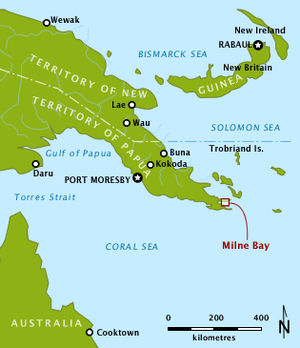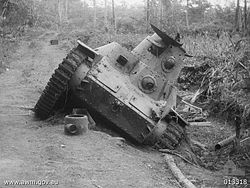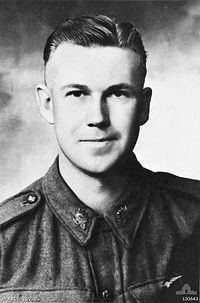- Battle of Milne Bay
-
Battle of Milne Bay Part of World War II, Pacific War 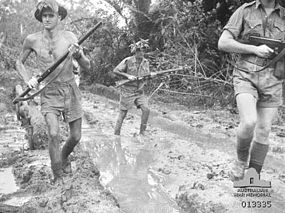
Australian troops at Milne Bay in 1942, shortly after the battleDate 25 August – 7 September 1942 Location Milne Bay, New Guinea Result Allied victory Belligerents  Australia
Australia
 United States
United States Empire of Japan
Empire of JapanCommanders and leaders  Cyril Clowes
Cyril Clowes Nishizo Tsukahara
Nishizo Tsukahara
 Masajiro Hayashi
Masajiro Hayashi
 Minoru Yano
Minoru YanoStrength 9,000 (half non-combat personnel) 1,800 + 350 (non-combat personnel) Casualties and losses about 170 dead 625 killed[1] Rabaul (land battle) – Rabaul (1942 air raids) – Bougainville action – Salamaua-Lae Invasion – Mo – Coral Sea – Buna-Gona Invasion – Kokoda Track – Milne Bay – Goodenough Island – Buna–Gona – Wau – Bismarck Sea – I-Go – Salamaua-Lae campaign – Chronicle – Cartwheel – Wewak raids – Finisterres – Huon Peninsula – Bougainville – Rabaul (1943 air raids) – New Britain – Admiralties – Emirau – Take Ichi – Western New GuineaThe Battle of Milne Bay, also known as Operation RE by the Japanese, was a battle of the Pacific campaign of World War II. Japanese marines attacked the Australian base at Milne Bay on the eastern tip of New Guinea on 25 August 1942, and fighting continued until the Japanese retreated on 5 September 1942. However armed resistance ended on 7 September 1942. The battle was the first in the Pacific campaign in which Allied troops decisively defeated Japanese land forces, forcing them to withdraw and completely abandon their strategic objective.
The Japanese hoped to secure an air and naval base to provide air and naval support to the Japanese Kokoda Track campaign to take Port Moresby, New Guinea by capturing the newly constructed airfields at Milne Bay.
The British Field Marshal Sir William Slim—who had no part in the battle—said:
"Australian troops had, at Milne Bay in New Guinea, inflicted on the Japanese their first undoubted defeat on land. If the Australians, in conditions very like ours, had done it, so could we. Some of us may forget that of all the Allies it was the Australian soldiers who first broke the spell of the invincibility of the Japanese Army; those of us who were in Burma have cause to remember."[2]
Japanese forces had experienced local setbacks before: their first attack on Wake Island was thrown back, and American Marines defeated the Japanese on Guadalcanal in the Battle of the Tenaru, four days before the Battle of Milne Bay began. But unlike Milne Bay, these actions did not result in complete Japanese withdrawal and the abandonment of the military campaign.
Contents
Background
Geography
Milne Bay is a sheltered bay located at the eastern tip of the Territory of Papua (now Papua New Guinea) and covers a sea area of 252,990 km². The bay is 36 kilometres (22 mi) long and 16 kilometres (9.9 mi) wide and is deep enough for large ships to enter. The area around the bay was occupied by plantations of palm oil, coconuts and cocoa. The coastal area is flat and was suitable for airstrips, although it is intercut by many tributaries of rivers and mangrove swamps. Due to the high rainfall and swampy lands, the area is prone to malaria.[3]
Military situation
The Allies had launched campaigns in July and August at Kokoda and Guadalcanal in response to the Japanese landing near Buna and Gona (Operation RI), on the north coast of New Guinea during the night of 21/22 July, were they attempted to advance south overland, along the Kokoda Track through the mountains of the Owen Stanley Range to seize Port Moresby and the start of construction of an airfield upon Guadacanal as part of a strategy of isolating Australia.[4]
Prelude
In May 1942 General Douglas MacArthur, Allied Commander in Chief of the South West Pacific Area (C in C SWPA), ordered the construction of an airfield at Milne Bay, as part of the proposed reconquest of Rabaul. The 46th (General Service) Engineers Regiment of the U.S. Army Corps of Engineers were deployed for the purpose of airfield construction. Troops were required to protect the new airfield as it would be a prize for the Japanese to attack. Once taken it could be a base for bombing sorties over the cities of south eastern Australia.[5]
Initially the 7th Brigade, a militia brigade, was dispatched consistting of the 9th, 25th and 61st Battalions as well as Companies A, C and a section of E Company of the 55th Battalion of the 14th Brigade. As construction work progressed this was progressively reinforced with regular troops of the 18th Infantry Brigade of the 7th Division, consisting of the 2/9th, 2/10th and 2/12th Battalions. The 9th Battery of 2/3rd Light Anti Aircraft Regiment, U.S. 709th Anti Aircraft Battery and the 9th Battery of 2/5th Field Regiment provided anti-airract and artillery support. Once the buildup was complete, the garrison assumed the name Milne Force, and Cyril Clowes, now promoted to Major General, was given command. He reached Milne Bay and assumed command of the Australian troops there just four days before the Japanese began landing.[6]
The Japanese discovered via aerial reconnaissance in early August that the Aliies were constructing airfields at Milne Bay. A few days afterwards the Japanese issued the orders to capture the airfields.
It was Japanese naval infantry, known as Kaigun Rikusentai (Special Naval Landing Forces), rather than the Imperial Japanese Army who attacked the Allied forces at Milne Bay. The Japanese high command committed approximately 850 marines from the 5th Kure Special Naval Landing Force (SNLF) led by Commander Masajiro Hayashi, a company of the 5th Sasebo SNLF, led by Lieutenant Fujikawa, 10th Naval Landing Force and 2nd Air Advance Party with 350 (non-combat) personnel from the 16th Naval Construction Unit. The Japanese force was led initially by Commander Shojiro Hayashi.
The Allied forces numbered 8,824, although only about 4,500 were infantry troops. The Japanese enjoyed a significant advantage in the form of light tanks, which the Allies had not deployed. The Japanese also had complete control of the sea during the night, allowing reinforcement and evacuation. However, the Royal Australian Air Force (RAAF) No. 75 and 76 Squadrons, flying P-40 Kittyhawk aircraft together with No. 6's Hudsons from No. 1 Strip at Milne Bay, which played a critical role in the fierce fighting, were largely uncontested during the day.
Battle
 Area of the Battle of Milne Bay, indicating some key locations.
Area of the Battle of Milne Bay, indicating some key locations.
From 4 August 1942, Japanese aircraft began to bomb Milne Bay in preparation for the landing.
The main Japanese invasion force left Rabaul on 24 August, under the command of Rear Admiral Mitsaharu Matsuyama. The fleet comprised the light cruisers Tenryū and Tatsuta, the destroyers Urakaze, Tanikaze and Hamakaze, the transports Nankai Maru and Kinai Maru, and the submarine chasers CH-22 and CH-24.
On 25 August, Milne Bay GHQ was alerted by an RAAF Hudson bomber near Kitava Island, of the Trobriand Islands and coastwatchers that a Japanese convoy of six escorts and three transports was approaching the Milne Bay area. HMAS Arunta—escorting the transport SS Tasman—left the Milne Bay area sailed for Port Moresby after learning of the invasion force. RAAF aircraft scrambled from No. 1 Strip and 12 RAAF P-40s and a Hudson strafed the convoy and attempted to bomb the transports, with 250 lb (110 kg) bombs near Rabi Island. Only limited damage was caused to the convoy and no ships were sunk. With night approaching, the RAAF returned to base.
The second group of invasion troops—from Buna—consisting of 350 marines of 5th Sasebo SNLF, led by Commander Tsukioka—was stranded on Goodenough Island, after they rested on the island and their barges were destroyed by No. 75 Squadron RAAF P-40s. It was intended that the second convoy would land at Taupota and cross the Stirling Range and attack the rear flank of the Milne Bay defenders.
Due to the attack on the main convoy, the Japanese were forced to land further from their main objective at Rabi, near the Milne Bay airbases. At 23:30 on 25 August, the Japanese landed 1,150 troops and two Type 95 Ha-Go tanks,[7] at Ahioma on the northern shore of Milne Bay, eleven kilometres east of their intended landing area.
D Company of the 61st Battalion was caught near the landing site at Ahioma, attempting to fall back to KB Mission and a small skirmish occurred. The D Company-requisitioned luggers Bronzewing and Elevala were disabled; however, the motor launch Dadosee escaped.
By dawn of 26 August, the Japanese had reached the main position of B Company of the 61st Battalion's around KB Mission. The Japanese suffered a serious setback when their base area was heavily attacked at daylight by RAAF Kittyhawks and a Hudson aircraft, as well as U.S. 5th Air Forces B-25s, B-26s and B-17s, killing a number of enemy troops, destroying supplies and a number of landing barges beached near the KB Mission. The destruction of the landing barges prevented their use to outflank the Australian battalions. The RAAF Kittyhawks were very close to the action, with aircraft strafing Japanese positions very shortly after taking off.
A counterattack by the 61st Battalion drove the Japanese from KB Mission; however, after six hours of intense fighting, the 61st Battalion withdrew to the Gama River. The battalion suffered 15 killed, 14 wounded and some missing, and the 25th Battalion, three killed and two missing.
The 2/10th Infantry Battalion (AIF) was ordered to the Gama River by Major General Cyril Clowes, and went into the offensive. However, they came upon the Japanese Type 95 tanks and valiantly tried to disable them with sticky bombs, which failed to stick due to the humid conditions of the tropics. The Japanese troops and the supporting tanks inflicted severe casualties on the 2/10th Infantry Battalion, who suffered 43 killed and 26 wounded. The 2/10th Infantry Battalion was forced to retreat to north of No. 3 Strip south of Kilarbo, on 27 August 1942. No. 3 Strip was under construction by the 46th (General Service) Engineers Regiment at the time. The 25th Battalion held the Japanese back and a two day lull followed.
On 29 August, Japanese reinforcements were landed consisting of 768 men from the 3rd Kure SNLF and 5th Yokosuka SNLF, with Commander Minoru Yano, who took over from Hayashi. The warships of the convoy shelled the allied positions at Gili Gili while offloading the reinforcements. The Type 95 Ha-Go light tanks were found by an Australian forward patrol on 30 August, near Rabi bogged in the mud abandoned due to their narrow tracks.
At 03:00 on 31 August, three banzai charges were repelled at No. 3 Strip with withering machine gun and mortar fire from 25th Battalion and 61st Battalion as well as the 46th (General Service) Engineers Regiment and artillery fire from the Australian 2/5th Field Regiment.
Lying across the [air]strip were dozens of dead Japs... As our officer crossed in the vanguard a Jap, apparently wounded, cried out for help. The officer walked over to aid him, and as he did the Jap sprang to life and hurled a grenade which wounded him in the face. From then on the only good Jap was a dead one, and although they tried the same trick again and again throughout the campaign, they were dispatched before they had time to use their grenade.
Our policy was to watch any apparent dead, shoot at the slightest sign of life and stab with bayonet even the ones who appeared to be rotten. It was all out from then on, neither side showing any quarter and no prisoners were taken.The 2/12th Battalion launched a counterattack at 09:00 on 31 August and pushed the Japanese back along the north coast of Milne Bay. They were joined by the 2/9th Battalion on 3 September and faced significant strong resistance on 4 September. The advance of a section from the Australian 2/9th Battalion was held up by fire from three Japanese machine gun positions. Corporal John French ordered the other members of the section to take cover before he attacked and destroyed two of the machine guns with grenades. French then attacked the third position with his submachine gun. The Japanese firing ceased and the Australian section advanced to find that the machine gunners had been killed and that French had died in front of the third position. He was posthumously awarded the Victoria Cross for his actions at Milne Bay.
Air operations
The RAAF No. 75 and 76 Squadrons together with No. 6 Squadron were instrumental in destroying the Japanese supply dumps and landing barges near Milne Bay during the fighting. No. 1 and No. 2 airfields were close to the front lines and the pilots often engaged the enemy shortly after taking off. Nine Kittyhawks were destroyed and seven pilots were killed.
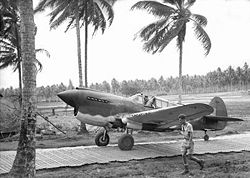 Sqn Ldr Keith "Bluey" Truscott, Commanding Officer of 76 Squadron, taxiing along Marston Matting (PSP) at Milne Bay in September 1942
Sqn Ldr Keith "Bluey" Truscott, Commanding Officer of 76 Squadron, taxiing along Marston Matting (PSP) at Milne Bay in September 1942
Japanese withdrawal
On 5 September, the Japanese high command ordered a withdrawal. On 6 September, the offensive reached the main camp of the Japanese landing force. The 2/9th Battalion had lost 30 killed and 90 wounded, the 2/12th Battalion 35 killed and 44 wounded.
Three Beaufighters of No. 30 Squadron RAAF and six Beauforts of No. 100 Squadron RAAF arrived at Milne Bay on 6 September 1942 to provide additional support against any further landings and provide anti-shipping missions. At night of the 6 September, Japanese light cruiser Tatsuta, part of the force assigned to evacuate the surviving troops after their defeat, bombarded the Gili Gili wharves and sank the MV Anshun.
The next night, further Japanese warships bombarded onshore positions. Patrols by Australian troops tracked down and killed Japanese troops trying to trek overland to Buna.
Aftermath
Base development
The Allies continued to develop the base area, known as "Advance Base A" (Code name:Pemmican), at Milne Bay in support of the the counter-offensive along the northern coast of Papua and New Guinea. Two coastal 155 millimetres (6.1 in) guns with searchlights were provided to portect the base from naval threats. New roads were built and the existing roads upgraded to ensure that they were passable during the wet conditions at Milne Bay. A new wharf replaced the old inadequate jetty. No. 1 Strip was rebuilt, and No. 3 Strip was completed and allowed the bombing of Rabaul and the northern Solomons without the need of cross the Owen Stanleys.[4] A trans shipment and staging area, major overhaul facilities for PT boats, a destroyer base and Station Hospital were also constructed at the base.[3]
War crimes
The Japanese committed war crimes at Milne Bay, namely the killing of surrendered prisoners of war and civilians. None of the thirty-nine Australian troops which were captured by the Japanese survived, having been executed with some showing signs of having been mutilated as well. At least 59 civilians were also murdered. As a result of the Moscow Declaration, the Minister for External Affairs, Dr. H. V. Evatt, commissioned a report by William Webb on war crimes committed by the Japanese. Webb took depositions from members of the Allied forces present about the Milne Bay incident which formed part of his report, which was submitted to the United Nations War Crimes Commission in 1944.[9]
Results
According to official figures, 311 Japanese personnel were killed with 301 missing in action. The Japanese navy evacuated 1,318 personnel. Of the 534 Australian casualties, 161 were killed or missing in action. The U.S. forces lost 14 personnel killed and several wounded.
The effect on the morale of all Allied servicemen in Asia and the Pacific was profound, but especially for other Australians fighting a rearguard action on the Kokoda Track and Slim's troops in the 14th Army who had been retreating in Burma.
The battle honour Milne Bay was subsequently awarded to the Australian 9th, 25th, 61st, 2/9th, 2/10th and 2/12th Battalions.[10]
Notes
References
- Brune, Peter (2003). A Bastard of a Place: The Australians in Papua – Kokoda, Milne Bay, Gona, Buna, Sanananda. Crows Nest, NSW: Allen & Unwin. ISBN 1-74114-403-5.
- Bullard, Steven (translator) (2007). Japanese army operations in the South Pacific Area New Britain and Papua campaigns, 1942–43. Senshi Sōshō (translated excerpts). Canberra: Australian War Memorial. ISBN 9780975190487. http://ajrp.awm.gov.au/ajrp/ajrp2.nsf/088031725e4569e4ca256f4f00126373/1fcb61d633972daaca257291000abf44?OpenDocument.
- Chan, Gabrielle (2003), War On Our Doorstep (Hardie Grant Books: South Yarra, Victoria, Australia)
- Department of the Navy, Bureau of Yards and Docks (1947). "Building the Navy's Bases in World War II, History of the Bureau of Yards and Docks and the Civil Engineer Corps 1940-1946 (Volume 1) )". Washington: United States Government Printing Office. http://www.ibiblio.org/hyperwar/USN/Building_Bases/bases-26.html. Retrieved 24 November 2011.
- Lundstrom, John B. (2005). First Team And the Guadalcanal Campaign: Naval Fighter Combat from August to November 1942 (New ed.). Naval Institute Press. ISBN 1-59114-472-8. http://books.google.com/books?id=xtaTS-POl-UC&printsec=frontcover#v=onepage&q=&f=false.
- McDonald, Neil & Brune, Peter (1999), 200 Shots: Damien Parer, George Silk and the Australians at War in New Guinea, Allen & Unwin.
- Milner, Samuel (15 March 1955). "HyperWar: US Army in WWII: Victory in Papua". http://www.ibiblio.org/hyperwar/USA/USA-P-Papua/index.html. Retrieved 23 November 2011.
- Maitland, Gordon (1999). The Second World War and its Australian Army Battle Honours. East Roseville, New South Wales: Kangaroo Press. ISBN 0864179758.
- Webb, William (October 1944). A Report on War Crimes Against Australians Committed by Individual Members of the Armed Forces of the Enemy. NAA (ACT): A10950 1.
Further reading
- Baker, Clive (2000). Milne Bay 1942 (4th ed.). Loftus, NSW: Australian Military History Publications. ISBN 0646054058.
- Coulthard-Clark, Christopher D. (2001). The Encyclopedia of Australia’s Battles (2nd ed.). Allen & Unwin. ISBN 1-86508-634-7.
- Gillison, Douglas (1962). Royal Australian Air Force, 1939–1942. Australia in the War of 1939–1945. Series 3 – Air. 1. Canberra: Australian War Memorial. http://www.awm.gov.au/collection/records/awmohww2/air/vol1/awmohww2-air-vol1-ch29.pdf.
- McCarthy, Dudley (1959). South–West Pacific Area – First Year: Kokoda to Wau. Australia in the War of 1939–1945. Series 1 – Army. 5. Canberra: Australian War Memorial. http://www.awm.gov.au/cms_images/histories/21/chapters/05.pdf.
- Macdougall, Anthony K. (2002). Australians at War: A Pictorial History (Revised ed.). The Five Mile Press. ISBN 1-86503-648-X.
Categories:- Conflicts in 1942
- 1942 in Papua New Guinea
- South West Pacific theatre of World War II
- Battles of World War II involving Australia
- Battles of World War II involving Japan
- Battles and operations of World War II involving Papua New Guinea
- Milne Bay Province
- Australia–Japan relations
Wikimedia Foundation. 2010.

